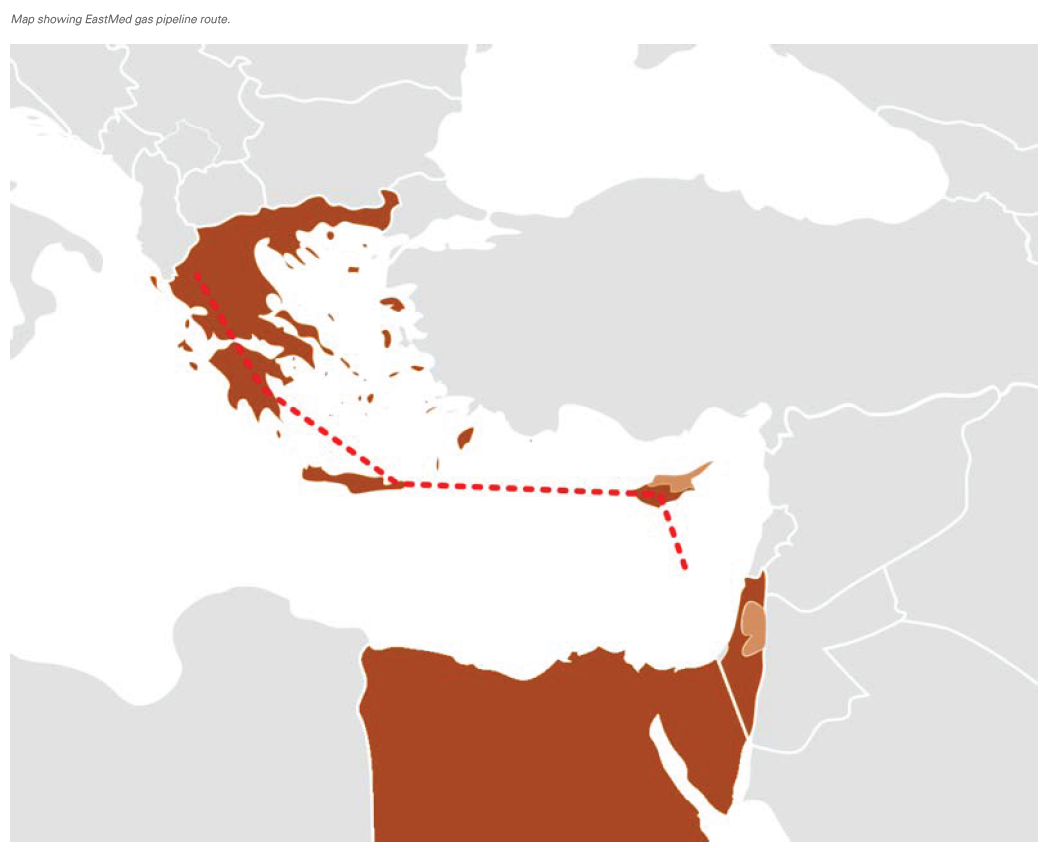Another blow for EastMed pipeline [Gas in Transition]
Cyprus appears to be losing interest in the long-discussed EastMed pipeline project as a means of delivering its offshore gas to European markets, in favour of a shorter link that would connect its fields with those off Israel. In Cyprus, both countries’ gas could be liquefied for delivery to Europe by ship.
The change in policy comes after a new centrist Cypriot government came to power in March.
“It’s a win-win,” Cypriot energy minister George Papanastasiou said of the shorter pipeline option in an interview with Reuters on June 20, . While EastMed has not been officially dropped, the minister noted it was “a very high, cost intensive project” that had “technical issues such as the depth of the sea where the pipelines need to be laid.”
EastMed has a planned length of 2,000 km, from Israel to Cyprus and then Greece, whereas the Israeli-Cypriot link would run for only 300 km.
EastMed has been debated for over a decade now, but has not made any serious headway. And there are a number of reasons to conclude that it is unlikely to do so.
Multiple challenges
EastMed was designed to provide an additional export route for gas from fields off Israel, including the Leviathan, Tamar, Tanin and Karish deposits. It would also enable the development of discoveries off Cyprus, including Aphrodite. The capacity of the pipeline was to be 10 bcm per year, initially, and potentially expanded to 20 bcm per year at a later point.
When it was conceived in 2012, the pipeline plan enjoyed strong support from EU authorities, which viewed it as a means of reducing reliance on Russian gas. Three years later it secured the status of an EU project of common interest.
The need to find alternatives to Russian gas is of course now greater than ever, following Gazprom’s drastic cut in supplies to Europe over the past year. However, the policies of the current European Commission – the Green Deal, the Fit-for-55 package, the RepowerEU package and the revised EU taxonomy, which labels gas as sustainable but only under very strict conditions – do not favour large-scale pipeline projects.
Such grand projects require long-term supply contracts to make them feasible. But the EU, and many European national governments, view shorter-term contracts for flexible LNG supply as preferable, in line with forecasts that natural gas demand will fall significantly over the coming years – RepowerEU envisages gas consumption more than halving by 2030.
Furthermore, Brussels will be more reluctant to grant direct funding to the project.
The Israeli-Cypriot link coupled with an LNG terminal, on the other hand, would require far less capital. Its gas could be delivered to a greater number of markets, and so there would be less of a need for longer-term supply contracts.
Also significant, EastMed lost the support of the US at the start of last year, with the state department senior advisor for energy security, Amos Hochstein, describing the project at the time as not only financially unfeasible, but mostly “driven by politics,” while “multibillion-dollar deals should be driven by the commercial side.”
The pipeline would also have to overcome opposition from Turkey, amid its long-running tensions with Cyprus and Greece over maritime borders and offshore oil and gas resources.
What next
The Israel-Cyprus link has the support of both Cypriot president Nikos Christodoulides and Israeli prime minister Benjamin Netanyahu, according to Papanastasiou.
“There will be two technical committees with experts from both sides, starting the conversation in July,” the ministry said. “The first committee will be gas and hydrogen, and the second committee electricity.”
By stressing that the pipeline could in the future carry clean hydrogen, it could be eligible for EU financial support, including the European Investment Bank and the European Bank for Reconstruction and Development. Both financiers are scaling back on financing for hydrocarbon projects, but the pipeline could be viewed as sustainable if it can one day swap gas for hydrogen flow.
“As soon as we develop the technologies and we have enough green power generation then the pipelines can be used for hydrogen transportation,” Papanastasiou said.
 The minister was implying that the pipeline would carry green hydrogen, derived from water using renewables-powered electrolysis. But given its route connecting gas fields, blue hydrogen would appear a more realistic option in the short term.
The minister was implying that the pipeline would carry green hydrogen, derived from water using renewables-powered electrolysis. But given its route connecting gas fields, blue hydrogen would appear a more realistic option in the short term.
Another doubt hanging over both EastMed and the Israel-Cyprus link is whether sufficient gas will become available and how quickly. Chevron, the operator of the Leviathan field, seems more interested in piping more gas to Egypt and a potential floating LNG project off Israel to make use of additional output. In February, when the US major presented its upcoming plans in the East Mediterranean, it notably discussed Israel and Egypt but made no mention of Cyprus.
Energean, another player offshore Israel, has expressed interest in exporting gas to Cyprus but not investing in the necessary infrastructure.
Meanwhile, most reserves off Cyprus need further appraisal to determine how much gas can be recovered and at what cost. Chevron began drilling an appraisal well at Aphrodite in May, and the result will be critical for confirming the project’s value.



